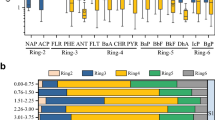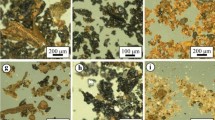Abstract
Profiles of the bioaccessibility of soil polycyclic aromatic hydrocarbons (PAHs) in different urban functional areas of Xiamen City, Fujian, China were investigated. A physiologically based in vitro test was used to evaluate the bioaccessibility of total and individual PAHs. There was no obvious correlation between total concentrations of PAHs and bioaccessibility during the gastrointestinal phase for the soils from different functional areas. Results showed that the bioaccessibility variation in the gastrointestinal phase (ranging from 14.6% to 63.2%) was significantly higher than that in the gastric phase (ranging from 4.9% to 21.8%). The bioaccessibility in the gastrointestinal phase was not only determined by soil organic materials but also directly related to physical and chemical properties of individual PAHs, except for two-ring PAHs. Increasing soil organic material content or decreasing ring numbers of PAHs could result in the decrease of PAH bioaccessibility. The total PAH bioaccessibility was largely contributed by individual PAHs with relatively high molecular weight.
Similar content being viewed by others
References
Aubin, S., & Farant, J. P. (2000). Benzo[b]fluoranthene, a potential alternative to benzo[a]pyrene as an indicator of exposure to airborne PAHs in the vicinity soderberg aluminum smelters. Journal of the Air & Waste Management Association, 50(12), 2093–2101.
Calabrese, E. J., Stanek, E. J., James, R. C., & Roberts, S. M. (1997). Soil ingestion: A concern for acute toxicity in children. Environmental Health Perspectives, 105(12), 1354–1358. doi:10.2307/3433755.
Chiou, C. T., McGroddy, S. E., & Kile, D. E. (1998). Partition characteristics of polycyclic aromatic hydrocarbons on soil and sediments. Environmental Science & Technology, 32(2), 264–269. doi:10.1021/es970614c.
Chung, N., & Alexander, M. (2002). Effect of soil properties on bioavailability and extractability of phenanthrene and atrazine sequestered in soil. Chemosphere, 48(1), 109–115. doi:10.1016/S0045-6535(02)00045-0.
Collins, J. F., Brown, J. P., Alexeeff, G. V., & Salmon, A. G. (1998). Potency equivalency factors for some polycyclic aromatic hydrocarbons and polycyclic aromatic hydrocarbon derivatives. Regulatory Toxicology and Pharmacology, 28(1), 45–54. doi:10.1006/rtph.1998.1235.
De Vries, W., & Bakker, D. J. (1998). Manual for calculating critical loads of heavy metals for terrestrial ecosystem: Guidelines for critical limits, calculation methods and input data (pp. 144–146). Wageningen, The Netherlands: TNO Institute of Environmental Sciences.
Dean, J. R., & Ma, R. (2007). Approaches to assess the oral bioaccessibility of persistent organic pollutions: A critical review. Chemosphere, 68(8), 1399–1407. doi:10.1016/j.chemosphere.2007.03.054.
Ghosh, U., Gillette, J. S., Luthy, R. G., & Zare, R. N. (2000). Microscale location, characterization, and association of polycyclic aromatic hydrocarbons on harbor sediment particles. Environmental Science & Technology, 34(9), 1729–1736. doi:10.1021/es991032t.
Hack, A., & Selenka, F. (1996). Mobilization of PAH and PCB from contaminated soil using a digestive tract model. Toxicology Letters, 88(1–3), 199–210. doi:10.1016/0378-4274(96)03738-1.
Harkey, G. A., Lydy, M. J., Kukkonen, J., & Landrum, P. F. (1994). Feeding selectivity and assimilation of PAH and PCB in Diporeia spp. Environmental Toxicology and Chemistry, 13(9), 1445–1455. doi:10.1897/1552-8618(1994)13[1445:FSAAOP]2.0.CO;2.
Holman, H. N., Goth-Goldstein, R., Aston, D., Yun, M., & Kengsoontra, J. (2002). Evaluation of gastrointestinal solubilization of petroleum hydrocarbon residues in soil using an in vitro physiologically based model. Environmental Science & Technology, 36(6), 1281–1286. doi:10.1021/es010987k.
Jin, Z. W., Simkins, S., & Xing, B. S. (1999). Bioavailability of freshly added and aged Naphthalene in soils under gastric pH condition. Environmental Toxicology and Chemistry, 18(12), 2751–2758. doi:10.1897/1551-5028(1999)018<2751:BOFAAA>2.3.CO;2.
Johnsen, A. R., & Karlson, U. (2007). Diffuse PAH contamination of surface soils: Environmental occurrence, bioavailability, and microbial degradation. Applied Microbiology and Biotechnology, 76(3), 533–543. doi:10.1007/s00253-007-1045-2.
Khan, S., Cao, Q., Lin, A., & Zhu, Y. (2008). Concentrations and bioaccessibility of polycyclic aromatic hydrocarbons in wastewater-irrigated soil using in vitro gastrointestinal test. Environmental Science and Pollution Research, 15(4), 344–353. doi:10.1007/s11356-008-0004-5.
Li, C. T., Lin, Y. C., Lee, W. J., & Tsai, P. (2003). Emission of polycyclic aromatic hydrocarbons and their carcinogenic potencies from cooking source to the urban atmosphere. Environmental Health Perspectives, 111(4), 483–487.
Lu, M., Yuan, D., Li, Q., & Ouyang, T. (2009). Application of response surface methodology to analyze the effects of soil/liquid ratio, pH and incubation time on the bioaccessibility of PAHs from soil in in vitro method. Water, Air, and Soil Pollution. doi:10.1007/s11270-008-9920-8.
Miller, M. M., Wasik, S. P., Huang, G. L., Shiu, W. Y., & Mackay, D. (1985). Relationships between octanol–water partition coefficient and aqueous solubility. Environmental Science & Technology, 19(6), 522–529. doi:10.1021/es00136a007.
Nelson, D. W., & Sommer, L. E. (1982). Total carbon, organic carbon and organic matter. Method of soil analysis. Chemical and microbiological properties (pp. 539–579). Madison, USA: American Society of Agronomy.
Oomen, A. G., Slips, A. J. A. M., Groten, J. P., Sijm, D. T. H. M., & Tolls, J. (2000). Mobilization of PCBs and Lindan from soil during in vitro digestion and their distribution among bile salt micelles and proteins of human digestive fluid and the soil. Environmental Science & Technology, 34(2), 297–303. doi:10.1021/es990446j.
Oomen, A. G., Hack, A., Minekus, M., Zeijdner, E., Cornelis, C., Schoeters, G., et al. (2002). Comparison of five in vitro digestion model to study the bioaccessibility of soil contaminants. Environmental Science & Technology, 36(15), 3326–3334. doi:10.1021/es010204v.
Oomen, A. G., Rompelberg, C. J. M., Kamp, E. V., Perehoom, D. P. K. H., Zwart, L. L. D., & Sips, A. J. A. M. (2004). Effect of bile type on the bioaccessibility of soil contaminants in an in vitro digestion model. Archives of Environmental Contamination and Toxicology, 46(2), 183–188.
Pan, B., Xing, B., Tao, S., Liu, W., Lin, X., Xiao, Y., et al. (2007). Effect of physical forms of soil organic matter on phenanthrene sorption. Chemosphere, 68(7), 1262–1269. doi:10.1016/j.chemosphere.2007.01.054.
Pu, X., Lee, L. S., Galinsky, R. E., & Carlson, G. P. (2004). Evaluation of a rat model versus a physiologically based extraction test for assessing phenanthrene bioavailability from soils. Toxicological Sciences, 79(1), 10–17. doi:10.1093/toxsci/kfh091.
Rastall, A. C., Neziri, A., Vukovic, Z., Jung, C., Mijovic, S., Hollert, H., et al. (2004). The identification of readily bioavailable pollutants in Lake Shkodra/ Skadar using semipermeable membrane devices (SPMDs), bioassays and chemical analysis. Environmental Science and Pollution Research, 11(4), 240–253. doi:10.1007/BF02979632.
Ruby, M. V., Davis, A., Link, T. E., Schoof, R., Chaney, R., Freeman, G. B., et al. (1993). Development of an in vitro screening test to evaluate the in vitro bioaccessibility of ingested mine-waste lead. Environmental Science & Technology, 27(13), 2870–2877. doi:10.1021/es00049a030.
Tang, X. Y., Tang, L. L., Zhu, Y. G., Xing, B. S., Duan, J., & Zheng, M. H. (2006). Assessment of the bioaccessi bility of polycyclic aromatic hydrocarbons in soils from Beijing using an in vitro test. Environmental Pollution, 140(2), 279–285. doi:10.1016/j.envpol.2005.07.010.
USEPA (1996). Method 3535A. Solid-phase extraction (SPE). http://www.epa.gov/osw/hazard/testmethods/sw846/pdfs/3535a.pdf.
USEPA (1999). Method 3546. Microwave extraction. http://www.epa.gov/epaoswer/hazwaste/test/pdfs/3546.pdf.
Van de Wiele, T. R., Verstracete, W., & Siciliano, S. D. (2004). Polycyclic aromatic hydrocarbon release from a soil matrix in the in vitro gastrointestinal tract. Journal of Environmental Quality, 33(4), 1343–1353.
Vasiluk, L., Pinto, L. J., Walji, Z. A., Tsang, W. S., Gobas, F. A. P. C., Eickhoff, C., et al. (2007). Benzo[a]pyrene bioavailability from pristine soil and contaminated sediment assessed using two in vitro models. Environmental Toxicology and Chemistry, 26(3), 387–393. doi:10.1897/06-343R.1.
Wang, D. G., Yang, M., Jia, H. L., Zhou, L., & Li, Y. F. (2008). Seasonal variation of polycyclic aromatic hydrocarbons in soil and air of Dalian areas, China: An assessment of soil-air exchange. Journal of Environmental Monitoring, 10(9), 1076–1083. doi:10.1039/b805840g.
Wang, Z., Chen, J., Qiao, X., Yang, P., Tian, F., & Huang, L. (2007). Distribution and source of polycyclic aromatic hydrocarbons from urban to rural soil: A case study in Dalian, China. Chemosphere, 68(5), 965–971. doi:10.1016/j.chemosphere.2007.01.017.
Zuo, Q., Duan, Y. H., Yang, Y., Wang, X. J., & Tao, S. (2007). Source apportionment of polycyclic aromatic hydrocarbons in surface soil in Tianjin, China. Environmental Pollution, 147(2), 303–310. doi:10.1016/j.envpol.2006.05.029.
Author information
Authors and Affiliations
Corresponding author
Rights and permissions
About this article
Cite this article
Lu, M., Yuan, D., Lin, Q. et al. Assessment of the bioaccessibility of polycyclic aromatic hydrocarbons in topsoils from different urban functional areas using an in vitro gastrointestinal test. Environ Monit Assess 166, 29–39 (2010). https://doi.org/10.1007/s10661-009-0982-x
Received:
Accepted:
Published:
Issue Date:
DOI: https://doi.org/10.1007/s10661-009-0982-x




